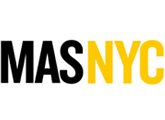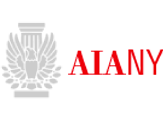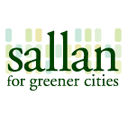
Point A:
Charting the High Performance Building Movement

New York City High Performance Building Series Event Two of Four
Event One | Event Two | Event Three | Event Four
NYC HPB Report (2) | The Clients' Perspective
On the eve of Mayor Bloomberg's signing the High Performance Building Bill, Intro. 324-A, which will require all new construction and renovations of city buildings, except housing, to meet standards equal to those in the Leadership in Energy and Environmental Design (LEED) program, the Municipal Art Society (MAS) hosted a panel led by Metropolis Editor and Chief, Susan Szenasy, entitled New York City High Performance Building: The Clients' Perspective.
On September 29, the second panel in a series sponsored by the Sallan Foundation, the MAS and the New York City Chapter of the American Institute of Architects Committee on the Environment explored three grassroots initiatives in New York City in order to enhance the dialogue among architects, engineers, developers, community groups, and government agencies involved in the burgeoning high performance building movement. The three projects, Susan Boyle's award winning Brooklyn Ice House development, Jeff Perlman's Greening a Block initiative, and Cecil Corbin-Mark's West Harlem Environmental Justice Center showcased the real and immediate possibilities of implementing sustainable and high performance building in New York City. At the conclusion of each presentation the moderator cleverly instigated further discussion with her line of questioning.
Susan Boyle, developer of the Brooklyn Ice House residential conversion in the Crown Heights neighborhood reviewed her project, winner of the New York City Department of Environmental Protection's 2004 Green Buildings Design competition, and posited two questions for consideration. How do we stimulate the green building market? And how do we mobilize the targeted green technology sector? Said Boyle, "We need to stimulate the private sector to really grab the attention of those who can create tax incentives and policies". She cited a German example where the government taxes storm water run-off, which in turn encourages the creation of permeable surfaces and green roofs.
Boyle then turned to the specific initiatives she used to in her development. The low-cost, "off the shelf", measures she implemented included selecting a site near mass transit that was appropriately oriented for greater sun exposure, increasing permeable surfaces on-site to reduce storm water run-off, increasing the fly ash concentration in the cement mixture to increase the strength of the cement while recycling coal power plant byproducts, the use of dual pane windows to increase insulation, and the use of light colored roofs to lower the overall cooling load on the structure. The more expensive and time consuming green initiatives for the Ice House included use of on-site salvaged materials such as bricks and wood beams, the installation of a photovoltaic array for on-site power generation, the laying of a green roof that doubles the life of the roof membrane as well as providing aesthetic, sound insulation, run-off reduction, and cooling benefits, and the installation of a radiant heat system. The radiant heat system was a sound choice for the renovation because this system heats up to 7 or 8 feet above the ground, an immense energy savings measure in a building with high ceilings. Boyle also installed boilers for each individual unit to act as an incentive for occupants to conserve energy.
Q: How did you become involved with green development?
A: I came from the sustainable transportation field, which led to an interest in sustainable architecture. My partner, however, was the one with the vision and the know how to get this project done. We had to do a lot of research, attend a lot of panels and conferences, and speak with as many experts as we could find to put together a solution. A lot of books, internet searches, and networking in the field occurred once we decided this is what we wanted to do.
Q: How were you able to find the appropriate resources and construction materials to build such a project?
A: We found a company, St. Lawrence Cement, that sold fly ash, and we had to put them and a ready cement company together to develop our unique cement mix. There were several instances where we had to act as the networkers, and bring companies together at the same table to implement our ideas. We have now begun a commercial redevelopment, and we have found that it gets easier as we continue into the future and learn from our experiences.
Q: How did you increase permeable surfaces in your project?
A: We had to jack hammer through a layer of cement around the building until we made it down to a cobblestone base. The gaps between the cobblestones allowed for natural drainage on-site. To reduce run-off from our largest impermeable surface (the roof) we installed a green roof.
Q: Did you take a lot of time to disassemble the structure to preserve and salvage materials?
A: There was a level of urgency present during construction because we needed to adhere to our project timeline. So, we did not necessarily go out of our way to preserve existing materials. We just made sure to go through a lot of the rubble and salvage what we could instead of throwing everything away. You have to remember that we were moving into the project upon its completion. So any delay meant a delay with our own home. We own, operate, and now live in the building.
The next speaker was Jeff Perlman, president of Bright Power Inc., who has just begun the Greening a Block initiative with Charles Komanoff of Komanoff Energy Associates and Lois Strum of the Neighborhood Energy Network. The concept of this program is to take an entire city block, and make most, if not all, of the buildings and units more energy efficient. The buildings undergo an energy audit as a first step in designing and executing an energy savings plan that will benefit both tenants and landlords . To reach its goal of 30% energy savings per building, the program will focus primarily on tuning boilers and heating systems, better insulating buildings, retrofitting lighting fixtures and updating appliances to achieve quantifiable gains in air quality, jobs, and energy conservation. Said Perlman, "Before worrying about the sexy and costly things like solar panels, we are looking at the real meat and potatoes stuff. There are a lot of little things overlooked that deliver big savings." Perlman continued that his program will eventually look into renewable energy systems, but that is not the initial focus. Developing the neighborhood scale for the program delivers several intended benefits. There has never been a real community spirit in New York City around conserving energy, and a neighborhood wide energy conservation effort, spurred by rising energy costs, has the potential to create an air of cooperative competition among residents and property owners to save energy. This friendly competition will enhance the dialogue among residents about their particular cost savings, and will stimulate contact with government institutions, like the New York State Energy Research and Development Authority (NYSERDA), which can further assist the neighborhood with direct funding, or indirectly encouraging residents to apply policy pressure on lawmakers. The program also offers an economy of scale that will enable faster and less expensive implementation of the plan by buying in bulk, consolidating work, and saving time. Greening a Block is currently completing a feasibility study for Manhattan Community Board 3, which has the means to fund this project through a legal settlement with the nearby 14th Street Con Edison power plant. Perlman estimates that the energy savings for one block will be 180,000 gallons of fuel per year, which is equivalent to $360,000 or 300 cars off the road.
Q: How did Greening a Block hit the ground running, so to speak?
A: Well, it was the settlement case with the Con Edison power plant on 14th Street in Manhattan that allowed us to dream big. This money has the potential to provide much of the necessary funds for our first block. In any other instance we would contact a block association or community group. We could also work with a co-op building, but no matter what, we need a quorum from the community to start our program. We began our meeting with Community Board 3, relevant subcommittees, local elected officials, and both tenants and landlords in the area. This started to spread the word about the opportunities of the program, especially the cost savings.
Q: Is there a timeline set for your efforts with Community Board 3?
A: We are in the process of finishing our feasibility study that we will present to the Community Board at an upcoming meeting. It is the Community Board that has the authority, with the approval of Con Edison and the City, to allocate money from the Settlement Fund to this project. Assuming everything goes smoothly, we hope to begin work in Spring, 2006.
Q: Are you aware of any other programs like this in our area?
A: Currently, we are the only one that we know of. We have done a comprehensive search and queried experts around the country and no one can point to a similar community-based, concentrated energy efficiency initiative. At Oberlin University in Ohio there is a competition between dorms to see which can use the least amount of energy. NYSERDA has an "Energy Target Zone" program, in which Greening A Block will participate, to focus energy efficiency improvements on particular blocks or neighborhoods. No other program has the advantage of the Settlement Fund, which needs to be spent in a concentrated area to help improve the environment for a particular community of people. We hope that we will be able to prove the concept with the help of the Settlement Fund money, and expect that we will be able to do many more blocks with other sources of financing in the future.
The final speaker was Cecil Corbin-Mark, Associate Director of West Harlem Environmental Action (WE ACT), which has been battling environmental injustices in north Manhattan for over three decades. The environmental group is currently developing plans to build the Environmental Justice Center, located on 140th Street in the Hamilton Heights historic district of Harlem, as their headquarters for community activism and education. Corbin-Mark said, "We needed to institutionalize our presence in the community, so we are thinking long-term with this facility". The Center, which is scheduled for completion in 2007, will stand as a beacon to the community of the past successes of the organization, and signify what is possible in the future. It will include a community training center, a library, an art space, a gathering place and offices for the organization itself.
As an embodiment of the group's work, the building will not only be a restoration of a historic building, but the transformation of a row house into an intricate piece of green architecture. The design is anchored by a central "environmental" shaft that brings light and air to the entire building. WE ACT also enlisted a local architectural firm, AQ Cursor Architects, to team up with Arup engineers on the project to expand the knowledge of green architecture within the immediate community. Said Corbin-Mark, "We want to expand minority architects who can accomplish these projects and train their colleagues in sustainable architecture." Corbin-Mark stressed that the primary goal of the campaign is to finish construction debt free. This important milestone is indicative of the organization's ultimate goal of an institution consigned to posterity.
Q: How are you raising money for this project?
A: We have begun our capital campaign, and we have hired a consultant, Michael Washburn, to coordinate this work. Our fundraising push will go after foundations that give capital grants, what we consider high profile individuals, and the community. We are also trying to use this campaign as a means to expand our own knowledge base and presence throughout New York. Thus far, we have raised one third of our $4 million construction cost. We are now hoping to secure funds from our elected officials for the project.
Q: Are you taking advantage of any New York State or City tax credit programs?
A: Yes, we are looking to enlist in NYSERDA's new construction program.
Q: What have you done to reach out to the Latino community?
A: Everything we print is in English and Spanish. In addition, we will soon begin printing in French to reflect the growing West African community. Our staff is as equally diversified as our neighborhood. The building design process as well as all of our programs reach out to every member of the community, including Latinos.
Q: Do you have a strong relationship with the school and educational institutions in the community?
A: We have a strong relationship with the schools in our community. In fact, students from Columbia University's architecture department sit on our buildings committee. Also, City College is currently involved with some of our programs, but we hope to increase their participation once the facility is constructed. Our local public and private schools also participate in our programs such as our air monitoring efforts. We want to have the community members become their own advocates, and we feel education of the next generation is a key component in this struggle.
Q: Given the existence of the environmental dangers in Harlem, is your community inherently more aware of environmental justice issues?
A: The community is very aware about our environmental issues. This is evidenced in their participation of our programs. Ideally we want to take this interest in the community and develop these individuals into leaders. We are in the business of putting ourselves out of business, and we hope the community will become the real advocates for environmental justice in the future.
Following these three presentations, there was an in-depth discussion about the sustainability movement. One attendee cited the recommendation made by the National Architectural Accreditation Board for more curriculum to concentrate on sustainable design throughout the nation's architecture programs. This recommendation arose from pressures from the student body. Another attendee pointed to a little known bill currently before the New York City Council, which would expedite green buildings through the City's Department of Buildings (DOB) code. This amendment, however, has been "pushed down the rabbit hole" according to one commenter, and needs greater attention. Another attendee announced that there is a group of City agencies, including the DOB that meets regularly about sustainability. This particular group is trying to formulate an array of sustainability standards for New York City government. Panelist Perlman concluded, "This whole movement is about working with all the components. We need to negotiate instead of yelling at one another."






